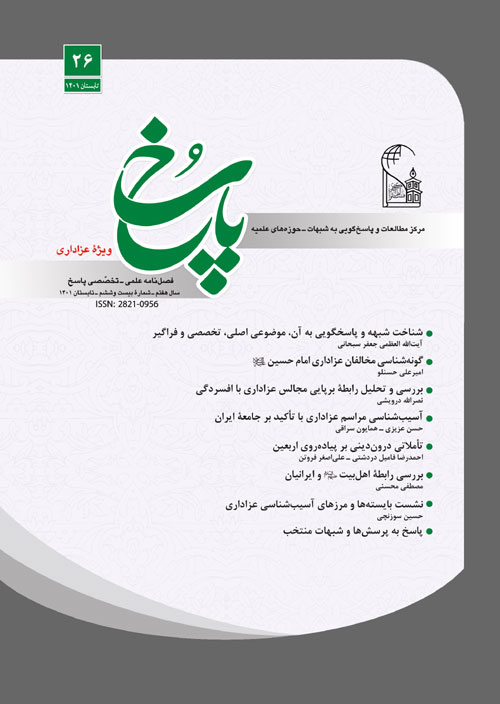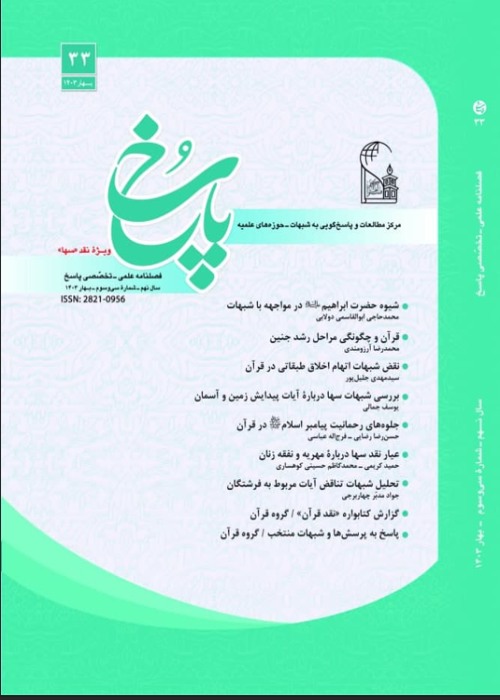فهرست مطالب

نشریه پاسخ
پیاپی 26 (تابستان 1401)
- تاریخ انتشار: 1401/08/10
- تعداد عناوین: 8
-
صفحات 11-25
عزاداری برای اهلبیت بهویژه امام حسین در ماه محرم و صفر فرهنگ دیرینی است که مورد تایید قرآنکریم و تاکید روایات است؛ اثرات بینظیری که بر برپایی عزای حضرت سیدالشهدا مترتب است سبب شده که در طول تاریخ و در سدههای اخیر مخالفان و جریانات معاندی به وجود آید؛ در این پژوهش که با استفاده از منابع کتابخانهای و به روش توصیفی انجامگرفته به دشمنشناسی مراسم عزاداری و راهکارهای مقابله با آن پرداخته شده است.
در بررسی تاریخی صورتگرفته مشخص گردید که وهابیت، حکومت پهلوی و برخی حکومتهای قبل از آن، برخی تحلیلگران و تحریفکنندگان از دشمنان اصلی برپایی مراسم عزاداری شناخته میشوند و راه مقابله با دشمنان و حفظ مراسم عزاداری از تحریفات اقداماتی نظیر در میدان بودن عالمان دین، فعالسازی مردم با افزایش دانش، اصلاحات بر محور دین، الگو قرار دادن ایمه اطهار% و تبیین سیره امام حسین8 است.کلیدواژگان: عزاداری، امام حسین (ع)، مخالفان، وهابیت، تحریفات -
صفحات 27-42
غم از هیجاناتی است که ابراز آن رفتاری طبیعی است و میتواند در شرایطی نوعی اختلال روانی بهحساب آید؛ برخی برپایی عزای اهلبیت عصمت و طهارت% بهویژه امام حسین (ع)را از مصادیق اختلال افسردگی مطرح کردهاند؛ در این پژوهش با استفاده از منابع کتابخانهای و به روش توصیفی به این سوال پرداخته شده است که «آیا برپایی مجالس عزا در سوگ ایمه اطهار% از مصادیق افسردگی است؟»؛ نتایج پژوهش نشان میدهد که براساس هیچیک از ملاکهای مطرح در تشخیص ناهنجاریها و اختلالات روانی ازجمله «راهنمای تشخیصی و آماری اختلالات روانی DSM» نهتنها برگزاری مراسم عزاداری و ابراز رفتاری هیجانی غم از مصادیق ناهنجاری و یا اختلال افسردگی نیست؛ بلکه براساس پژوهشهای انجامگرفته اینگونه مراسمها باعث شادی، نشاط و آرامش است.
کلیدواژگان: عزاداری، افسردگی، هیجان، غم، شادی، نشاط، آرامش -
صفحات 43-68
مصون ماندن دین اسلام از انحرافات در صدر اسلام و در طول تاریخ مرهون فداکاری امام حسین8 است؛ ظرفیتهای موجود در قیام امام حسین(ع) این فرصت را فراهم کرده است که پس از هزاروچند صدسال، هرساله عزای امام حسین(ع9 برپا گردد و در این مراسمها معارف دینی عرضه گردیده و راه بر انحرافات بسته میشود؛ مسیله تهدیدکننده اینکه گاهی همین مراسمهایی که به نام عزاداری و دین برپا میشود خود دچار تحریف و آفت میگردد.
پژوهش پیش رو که با استفاده از منابع کتابخانهای و به روش توصیفی انجامگرفته به آسیبشناسی عزاداری با تاکید بر جامعه ایران پرداخته است؛ بررسیها وجود و یا زمینههای بروز برخی انحرافات را نشان میدهد که بر اساس منابع دینی موردبررسی قرارگرفتهاند؛ برخی آسیبها و آفات عبارتنداز: اصل قرار گرفتن شور و تضعیف شناخت، تحریف هدف قیام، دروغ، بزرگنمایی، طرح مباحث موهن، قمهزنی، استفاده از سبکهای نامناسب، کاسبکاری از طریق مجالس عزاداری و خرافات.کلیدواژگان: مجالس عزاداری، جامعه ایران، آسیب شناسی، انحرافات، منابع دینی -
صفحات 69-84
در سالهای اخیر پیادهروی اربعین حال و هوای دیگری یافته و با استقبال کمنظیر اقشار مختلف مردم روبهرو شده است؛ ازاینرو افراد گوناگونی از خاستگاه تایید یا انتقاد از این حرکت اجتماعی، به تفسیر، تحلیل و تبیین مبانی، آثار و پیامدهای آن پرداختهاند. در این نوشتار که به شیوه کتابخانهای و با رویکرد توصیفی تحلیلی انجامگرفته است، مقاله آقای علی افشاری با عنوان «ملاحظاتی درون دینی در خصوص پیادهروی اربعین» بررسی و نقد شده و به آثار کمنظیر این مراسم اشاره شده است. بررسی و مطالعه ابعاد مختلف مراسم پیادهروی اربعین نشان داد که اربعین، مقطع پایانیافتن اسارت اهلبیت%، کاملشدن رسالت حضرت زینب$ و امام سجاد8 در رسواساختن یزیدیان و رساندن پیام خون سرخ امام حسین8 به گمراهان کوفی و شامی است؛ از سوی دیگر اربعین، مبدا حرکت جوشنده و تمامنشدنی تبلیغ و ترویج فرهنگ حسینی، اعلان بیعت با ولی خدا و درواقع نوعی مهاجرت نمادین را از خود به سمت امام و بهترین فرصت آشنایی و تعمیق روابط معنوی، سیاسی و فرهنگی شیعیان جهان است!
کلیدواژگان: اربعین، پیاده روی اربعین، زیارت امام حسین (ع)، زیارت اربعین -
صفحات 85-100
علیرغم آنکه تاریخ علاقه ایرانیان به اسلام و اهلبیت پیامبر مکرم اسلام% به صدر اسلام میرسد و امروز نیز ایران اسلامی به محبت و پیروی از ایمه معصومین(ع) شناخته میشود، برخی تلاش دارند قلبها را از محبت اهلبیت% پیامبرq برگردانند؛ تمسک به برخی روایات غیرمعتبر و تحریف متون ازجمله شیوههایی است که در شبههافکنی از آن استفاده میکنند؛ در این پژوهش به بررسی روایتی منسوب به امام حسین8 پرداختهشده که در آن ایرانیان، دشمن اهلبیت% معرفیشدهاند؛ با استفاده از منابع کتابخانهای و به روش توصیفی روایت مذکور و روایات دیگر ازایندست موردبررسی قرار گرفت و مشخص گردید که روایت مذکور ازلحاظ سندی اعتبار نداشته و قابلیت نسبت دادن ندارد؛ نکته دوم اینکه آنچه نسبت داده شده به فرض صحت استناد، مورد تحریف به زیاده قرارگرفته است؛ نکته سوم اینکه ترجمهای غیرکارشناسی از روایت ارایه شده بهگونهای که معنای روایت تحریفشده است؛ نکته چهارم اینکه برفرض صحت استناد، صحت ترجمه و عدم تحریف در متن به روایات معارض توجهی نشده است؛ درحالیکه روایات متعددی در تمجید و تکریم ایرانیان وجود دارد.
کلیدواژگان: ایرانیان، دشمنی، اهل بیت (ع)، امام حسین (ع)، عرب، عجم -
صفحات 101-131
-
صفحات 133-157
-
Pages 11-25
Mourning for the Ahl al-Bayt (a.s.), especially Imam Hussain (a.s.) in the month of Muharram and Safar, is an ancient culture that is confirmed by the Holy Quran and emphasized by traditions. The unique effects of mourning for the Sayed al-Shuhada (AS) have led to the emergence of opponents and opposing movements throughout history and in recent centuries. In this research, which was carried out using library sources and in a descriptive method, the antagonism of the mourning ceremony and the strategies to deal with it have been discussed. In the historical investigation, it was found that the Jewish people, Wahhabism, the Pahlavi government, and some governments before that, some analysts and distorters can be considered the main enemies of the mourning ceremony. The way to confront the enemies and preserve the mourning ceremony from distortions is also with measures such as the presence of religious scholars, activating people (by increasing knowledge), reforming thoughts on the axis of religion, setting the example of the pure imams and, especially, explaining the life of Imam Hussain (a.s.). , it is possible.
Keywords: mourning, Imam Hussein (AS), Opponents, Wahhabism, distortions -
Pages 27-42
Sadness is one of the emotions that is a normal behavior and of course, it can be considered as a symptom of a mood disorder in certain circumstances. Some people have assumed the mourning of Ahl al Bayt (A.S.) and especially Imam Hussain (A.S.) as examples of depression. In this research, using library sources and in a descriptive way, the question that "is the holding of mourning gatherings in the mourning of Athar imams is one of the examples of depression or not?" The results of the research show that according to none of the criteria in the diagnosis of mental disorders (including the Diagnostic and Statistical Manual of Mental Disorders - DSM), not only holding a mourning ceremony is not an example of depression, but such a ceremony also creates vitality and peace.
Keywords: mourning, depression, excitement, sadness, vitality, peace -
Pages 43-68
The preservation of Islam from the deviations at the beginning of Islam and throughout history is due to the sacrifice of Imam Hussain (AS). The capacities available in the uprising of Imam Hussain (a.s.) have made it possible to hold the mourning ceremony of Imam Hussain (a.s.) every year after thousands and hundreds of years. Of course, religious education is provided in this ceremony to close the way of deviations as much as possible. It is a pity that sometimes these gatherings, which are held in the name of mourning for Imam Hussain (peace be upon him), are also distorted and plagued. The upcoming research, which has been conducted using library sources and descriptive methods, has dealt with the pathology of mourning ceremonies with an emphasis on Iranian society. Investigations based on religious sources show the existence or causes of some deviations, such as: giving authenticity to feelings, paying little attention to knowing the message and life of Imam Hussain (AS), and distorting the purpose of the uprising of Imam (AS). , lying, exaggerating some events, raising offensive topics, using a machete, using inappropriate styles of mourning, paying attention to the financial aspects of mourning gatherings, and spreading superstitions.
Keywords: mourning gatherings, Iranian society, pathology, deviations, religious sources -
Pages 69-84
In recent years, the Arbaeen walk has acquired a different atmosphere and has been welcomed by different classes. Therefore, different people have interpreted, analyzed and explained the foundations, effects and consequences of this social movement from the point of view of approval or criticism. In this article, which is done in a library style and with a descriptive-analytical approach, while examining and criticizing Mr. Ali Afshari's article entitled intra-religious considerations regarding Arbaeen walking, the unique effects of this ceremony are pointed out. Examining the various aspects of this movement shows that Arbaeen is the end of the captivity of Ahl al-Bayt (a), the completion of the mission of Zainab bint Ali (a) and Imam Sajjad (a) to disgrace the Yazidis, and the bloody message of Imam Hussain (a) to the ears of the misguided people of Kufa and Sham will be served. On the other hand, Arbaeen has been the origin of the raging and endless movement to propagate and promote Hosseini's culture, declaration of allegiance to the guardian of God, and in fact a symbolic migration from "self" to "Imam (AS)". This memorial is the best opportunity to know and deepen the spiritual, political and cultural relations among the Shiites of the world.
Keywords: Arbaeen walk, pilgrimage of Imam Hussain (AS), Arbaeenpilgrimage -
Pages 85-100
The history of Iranians' interest in Islam and the Ahl al-Bayt of the Holy Prophet of Islam (AS) reaches the beginning of Islam, and even today, Islamic Iran is known for the love and following of the infallible Imams (AS). Some people try to cast doubt on this issue by insisting on some unreliable traditions and distorting religious texts. In this research, a hadith attributed to Imam Hussein (a.s.) has been investigated, in which the Iranians are introduced as the enemy of the Ahl al-Bayt (peace be upon them). Using library sources and descriptive methods, the mentioned hadith and other similar hadiths have been investigated. It was found that it is not authentic from the point of view of a document and cannot be attributed. Another thing is that assuming the authenticity of the reference, this hadith has been distorted a lot. Thirdly, a non-expert translation of that hadith has been presented in such a way that its meaning is distorted. Fourthly, even assuming the correctness of the citation and translation, as well as the absence of distortion in the text of this hadith, the contrary hadiths have not been paid attention to. While there are many other hadiths praising and honoring Iranians.
Keywords: Iranians, Ahl al-Bayt (peace be upon them), Imam Hussein(AS), distortion, citation -
Pages 133-157


